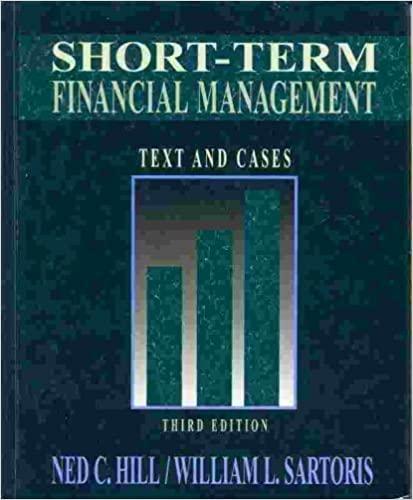Question
1. )Through the effects of financial leverage, when EBIT increases, ________. a. earnings per share will increase b. earnings per share will decrease c. fixed
1. )Through the effects of financial leverage, when EBIT increases, ________. a. earnings per share will increase b. earnings per share will decrease c. fixed operating costs will decrease d. fixed operating costs will increase
2.) A large portion of the commercial paper is issued by ________. a. commercial finance companies b. government agencies c. venture capitalists d. small manufacturing firms
3.) Although a firm's existing mix of financing sources may reflect its target capital structure, it is ultimately ________. a. the internal rate of return that is relevant for evaluating the firm's future investment opportunities b. the marginal cost of capital that is relevant for evaluating the firm's future investment opportunities c. the risk-free rate of return that is relevant for evaluating the firm's future investment opportunities d. the risk-free rate of return that is relevant for evaluating the firm's future financing opportunities
4.) Revenue stability affects ________. a. dividend risk b. maturity risk c. business risk d. interest rate risk
5.) A negative cash conversion cycle ________. a. means that the operating cycle exceeds the average inventory period b. means that the average payment period exceeds the operating cycle c. indicates that a firm is shortening its average payment period and lengthening its average collection period d. indicates that a firm is shortening its average age of inventory and average payment period
6.) Commercial paper is issued in multiples of ________. a. $1,000 or more b. $10,000 or more c. $100,000 or more d. $1,000,000 or more
7.) Which of the following is an advantage of NPV? a. It measures the risk exposure. b. It takes into account the time value of investors' money. c. It is highly sensitive to the discount rates. d. It measures how quickly a firm can breakeven.
8.) The inexpensive nature of long-term debt in a firm's capital structure is due to the fact that ________. a. the debt holders are the true owners of the firm b. equity capital has a fixed return c. long-term debt has a fixed return and a maturity date d. dividend payments are tax-deductible
9.) A ________ agreement normally states the exact conditions and procedures for the purchase of an account. a. factoring b. pledging accounts receivable c. revolving credit d. line of credit
10.) The total cost of a firm's inventory is found by summing the ________. a. order cost and the marginal cost of a firm's inventory b. order cost and the carrying cost of a firm's inventory c. order cost and the actual cost of a firm's inventory d. carrying cost and the marginal cost of a firm's inventory
11.) Which of the following is an attribute of a banker's acceptance? a. It is an unsecured note of issuer with large denominations. b. It has a maturity of 1 day to 3 years. c. Its risk and return is higher than U.S. Treasury issues. d. It is issued by a corporation with a high credit standing.
12.) If the cash discount period is increased, a firm's investment in accounts receivable is expected to ________. a. increase because existing customers attracted by the new policy will buy more products b. decrease because of nondiscount takers paying earlier to avail the cash discount c. decrease because discount takers will pay more in order to get more discount d. decrease because new customers will doubt the quality of product due to increase in discount
13.) ________ refers to the effects that fixed costs have on the returns that shareholders earn. a. Purchase power parity b. Leverage c. Business risk d. Pecking order theory
Step by Step Solution
There are 3 Steps involved in it
Step: 1

Get Instant Access to Expert-Tailored Solutions
See step-by-step solutions with expert insights and AI powered tools for academic success
Step: 2

Step: 3

Ace Your Homework with AI
Get the answers you need in no time with our AI-driven, step-by-step assistance
Get Started


